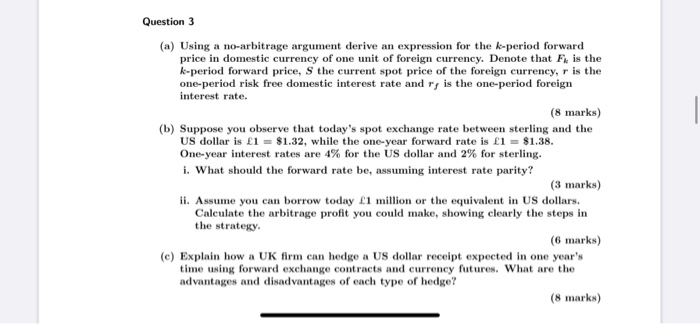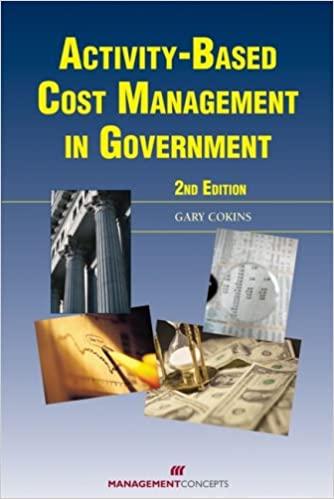For this question, i have attached the commentaries/answers. However, i still do not understand Q3 (a)(i) and (d). I would require a detailed explanation/answer for part(a)(i) and (d). Thank you so much!

Question 3 (a) Using a no-arbitrage argument derive an expression for the k-period forward price in domestic currency of one unit of foreign currency. Denote that F, is the k-period forward price, S the current spot price of the foreign currency, r is the one-period risk free domestic interest rate and ry is the one-period foreign interest rate. (8 marks) (b) Suppose you observe that today's spot exchange rate between sterling and the US dollar is 1 = $1.32, while the one-year forward rate is 11 = $1.38. One-year interest rates are 4% for the US dollar and 2% for sterling. i. What should the forward rate be, assuming interest rate parity? (3 marks) ii. Assume you can borrow today 1 million or the equivalent in US dollars. Calculate the arbitrage profit you could make, showing clearly the steps in the strategy (6 marks) (c) Explain how a UK firm can hedge a US dollar receipt expected in one year's time using forward exchange contracts and currency futures. What are the advantages and disadvantages of each type of hedge? (8 marks) Reading for this question Subject guide, Chapter 9 Approaching the question (a) An investor holding S has two possible investment strategies. The first is to deposit the funds at the sterling interest rate to yield S(1 + r) at maturity. The second strategy is to exchange sterling for the foreign currency at the current spot rate, where one unit of the foreign currency costs S, and deposit the foreign currency at the foreign interest rate. At maturity the value of the foreign deposit will be (1+r)". Exchanging this back into the domestic currency yields F (1 + r)* Since the interest rates are known and fixed and the spot and forward rates are both known from the beginning, both strategies are riskless and should, therefore, have the same payoff Equating the two payoffs gives $(1+r)* = F/(1+r) Rearranging gives the no-arbitrage condition: FAS = $(1+r)". (b) i. Under interest rate moito ==(1+)". (b) i. Under interest rate parity: FS Plugging in the numbers gives the forward rate 1 = $1.3459. ii. The actual forward rate is higher than you would expect. To exploit this: Borrow $1.32m now, exchange into at the spot rate to give Elm. After one year including the interest you have 1.02m. Exchange this into $ at the forward rate $1.38 to give $1.4076m. Pay off the Sborrowing plus interest which is $1.3728m. The arbitrage profit is $0.0348m. 7 FN2191 Principles of corporate finance (c) Forward exchange contracts enable the firm to lock in an exchange rate today at which they will sell dollars for sterling in one year's time. The firm can enter into a forward contract to sell US $ in one is eliminates uncertainty and the FN2191 Principles of corporate finance (e) Forward exchange contracts enable the firm to lock in an exchange rate today at which they will sell dollars for sterling in one year's time. The firm can enter into a forward contract to sell US $ in one year's time at today's forward price. This eliminates uncertainty and the risk that the future spot rate may be unfavourable. Disadvantages: they also eliminate the upside potential of a favourable exchange rate movement; they are binding contracts so not suitable for uncertain transactions, not all firms can access the forward market. The firm could use currency futures to hedge the risk of an unfavourable exchange rate movement. Unlike forwards they are tradeable, so more suitable for uncertain transactions. To hedge the receipt a sterling futures position would be set up which is closed out by a later opposite transaction. Gains on the futures price will offset adverse movements on the spot price and vice versa. They are more accessible for small firms than forwards. Disadvantage: it is difficult to create a perfect hedge due to the standardised nature of the contracts and basis risk. Question 3 (a) Using a no-arbitrage argument derive an expression for the k-period forward price in domestic currency of one unit of foreign currency. Denote that F, is the k-period forward price, S the current spot price of the foreign currency, r is the one-period risk free domestic interest rate and ry is the one-period foreign interest rate. (8 marks) (b) Suppose you observe that today's spot exchange rate between sterling and the US dollar is 1 = $1.32, while the one-year forward rate is 11 = $1.38. One-year interest rates are 4% for the US dollar and 2% for sterling. i. What should the forward rate be, assuming interest rate parity? (3 marks) ii. Assume you can borrow today 1 million or the equivalent in US dollars. Calculate the arbitrage profit you could make, showing clearly the steps in the strategy (6 marks) (c) Explain how a UK firm can hedge a US dollar receipt expected in one year's time using forward exchange contracts and currency futures. What are the advantages and disadvantages of each type of hedge? (8 marks) Reading for this question Subject guide, Chapter 9 Approaching the question (a) An investor holding S has two possible investment strategies. The first is to deposit the funds at the sterling interest rate to yield S(1 + r) at maturity. The second strategy is to exchange sterling for the foreign currency at the current spot rate, where one unit of the foreign currency costs S, and deposit the foreign currency at the foreign interest rate. At maturity the value of the foreign deposit will be (1+r)". Exchanging this back into the domestic currency yields F (1 + r)* Since the interest rates are known and fixed and the spot and forward rates are both known from the beginning, both strategies are riskless and should, therefore, have the same payoff Equating the two payoffs gives $(1+r)* = F/(1+r) Rearranging gives the no-arbitrage condition: FAS = $(1+r)". (b) i. Under interest rate moito ==(1+)". (b) i. Under interest rate parity: FS Plugging in the numbers gives the forward rate 1 = $1.3459. ii. The actual forward rate is higher than you would expect. To exploit this: Borrow $1.32m now, exchange into at the spot rate to give Elm. After one year including the interest you have 1.02m. Exchange this into $ at the forward rate $1.38 to give $1.4076m. Pay off the Sborrowing plus interest which is $1.3728m. The arbitrage profit is $0.0348m. 7 FN2191 Principles of corporate finance (c) Forward exchange contracts enable the firm to lock in an exchange rate today at which they will sell dollars for sterling in one year's time. The firm can enter into a forward contract to sell US $ in one is eliminates uncertainty and the FN2191 Principles of corporate finance (e) Forward exchange contracts enable the firm to lock in an exchange rate today at which they will sell dollars for sterling in one year's time. The firm can enter into a forward contract to sell US $ in one year's time at today's forward price. This eliminates uncertainty and the risk that the future spot rate may be unfavourable. Disadvantages: they also eliminate the upside potential of a favourable exchange rate movement; they are binding contracts so not suitable for uncertain transactions, not all firms can access the forward market. The firm could use currency futures to hedge the risk of an unfavourable exchange rate movement. Unlike forwards they are tradeable, so more suitable for uncertain transactions. To hedge the receipt a sterling futures position would be set up which is closed out by a later opposite transaction. Gains on the futures price will offset adverse movements on the spot price and vice versa. They are more accessible for small firms than forwards. Disadvantage: it is difficult to create a perfect hedge due to the standardised nature of the contracts and basis risk











